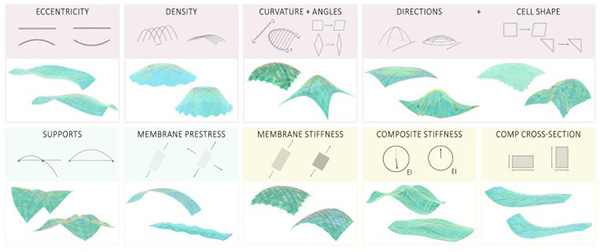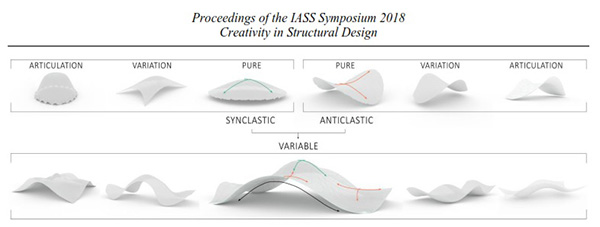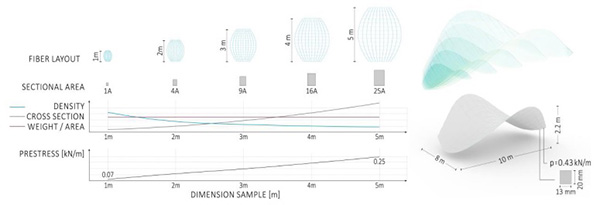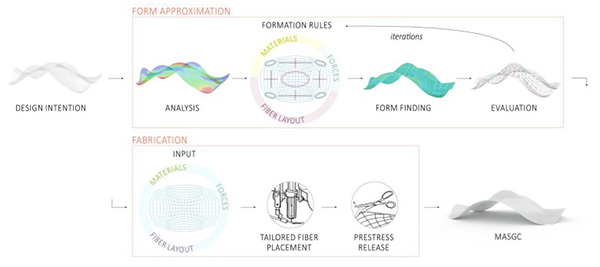Tailoring Self-Formation
Tailoring Self-Formation
fabrication and simulation of membrane-actuated stiffness gradient composites
Lotte ALDINGERa, Georgia MARGARITIa, Axel KÖRNERa, Seiichi SUZUKIa, Jan KNIPPERSa
AInstitute of Building Structures and Structural Design (itke), Faculty of Architecture and Urban Planning,University of Stuttgart, Germany, Keplerstrasse 11, 70174 Stuttgart, Germany

Figure 1: Concept of tailoring self-formation of the membrane-actuated stiffness gradient composites
This paper presents a design to fabrication framework for the mold-less construction of double curved composite lattice surfaces based on inherent material behavior. Fiber reinforced composite strands are sewn onto a flat prestressed high-strain membrane with the tailored fiber placement technique.
Through the prestress release the contracting membrane actuates active bending of the composite elements, thus the system self-forms into an anticipated double curved geometry. Its geometric outcome is tailored by the stiffness gradient of the composites. The material system is introduced by the authors with the term membrane-actuated stiffness gradient composites (MASGC).

Figure 2: Form finding with finite element methods with theory third order analysis in Sofistik
The primary focus of this research is to establish the rules of self-formation on the basis of the system’s governing parameters. Therefore, the fundamentals of the generation of synclastic and anticlastic curvatures, as well as combinations of both, from flat fibrous grids are revealed. Simulations with nonlinear finite element methods are deployed for the MASGC’s form finding.
The resulting understanding leads to the definition of rules for a form approximation process, where the system’s input parameters are determined so that the self-formation satisfies an initial design intention. This control enables the exploration of the MASGC’s design space.

Figure 3: Impact of cell angles and eccentricity on the generation of double curvature from a flat grid
Furthermore, the MASGC’s scalability and structural performance is evaluated. The proposed system offers the advantage to build lightweight surfaces of tailored variable double curvatures through rapid digital fabrication and mold-less formation.

Figure 4: Rules of Self-Formation for all the parameters of the system illustrated with examples of MASGCs
The demand for customized double curved surfaces is increasing in contemporary architectural design and construction. These surfaces are of interest by virtue of their appealing form as well as their advantageous structural performance among others. Fiber reinforced polymers (FRP) offer a high degree of customization and the ability to construct lightweight structures.
Thus composite panels find application as façade elements with customized freeform shapes. However, their complex and costly fabrication is a current issue throughout all design fields. Conventionally double curved composites are manufactured through manual lamination onto CNC-milled expanded polystyrene molds. This entails a vast amount of waste, technology and labor.

Figure 5: Rules of self-formation for form approximation of variable double curvature and their derivation
Consequently, this mold process is more suitable for mass production, rather than for individualized designs as are common in the field of avant-garde architecture. Alternatively, double curved geometries can be formed by initially planar grids undergoing distortion or by tessellation into planar segments or into bending-active developable plates. However, these solutions result in less smooth surfaces and necessitate erection and connection strategies.

Figure 6: Design space of the MASGC, with synclastic, anticlastic and variable curvatures and generic variations
A basis for an intelligent method to shape complex geometries is through a system inherent material behavior. Research has been conducted by on material behavior based design, where solely through the interaction of contracting actuators and bending elements, forms are generated in one-step without molds.
Yet, their behavior is not investigated to a degree where an anticipated geometry with controlled Gaussian curvature can be formed. Moreover, this would demand freedom and control in the stiffness layout. Digital fabrication with the tailored fiber placement technology (TFP), originating from the aerospace industry, enables a precise and automated fiber reinforced composite application onto a substrate membrane. Conventionally their fiber layouts are informed for an optimized structural performance, while their geometry is formed through molding.

Figure 7: Scalability of the Self-Formation of the MASGC, with suitable prestress, cross-section and density
This research aims to combine the presented advantages in a material system introduced by the authors with the term membrane-actuated stiffness gradient composites (MASGC). The proposed system offers the construction of lightweight, composite surfaces of tailored variable double curvatures through rapid digital fabrication and mold-less self-formation, relying solely on the systems inherent material behavior.

Figure 8: Design to fabrication framework, e.g. for MAGC with irregular variable double curvature
Thus, it offers a high degree of customization and in return minimizes material use, labor and waste. Fiber reinforced composite strands are sewn onto a flat prestressed high-strain membrane with the tailored fiber placement technique. Through the prestress release the contracting membrane actuates active bending of the composite elements, thus the system self-forms into an anticipated double curved geometry (Figure 1).
Its geometric outcome is tailored by the stiffness distribution and fiber layout. Through extensive form-finding with nonlinear finite element methods, self-formation rules are derived that enable form approximation. A process where the input parameters of the system are determined so that the self-formation satisfies an initial design intention. The research on the MASGC is concluded in a design to fabrication framework.

Figure 9: Fabrication of the MASGC through CFRP application with the tailored fiber placement technique. Total workspace of the TFP machine 2.75m by 1m with workspace of 4 individual sewing heads 1.25m by 1m.
With the proposed concept of tailoring self-formation with the MASGC, composite surfaces with a wide range of designs exhibiting positive, negative and variable Gaussian curvatures can be formed solely through the material behavior of the system. The design to fabrication framework enables the fabrication of customized surfaces with high geometric control in a digital fabrication and mold-less, one-step formation process.

Figure 10: MASGC prototypes with synclastic, anticlastic (with GFRP), and variable curvatures (with CFRP)
This control is achieved through the establishment of the self-formation rules. It is demonstrated that all the parameters of the system, in particular the membrane stiffness, eccentricity and cross-sectional ratio, determine the self-formation into double curved surfaces. However, the most crucial aspect for controlling double curvature in the MASGC is the insight on the impact of the cells angles and their distortion.
This can be considered a vital contribution to the general discourse on the control of double curvature. Furthermore, the critical dilemma of bending active structures, of too stiff for formation and too weak for structural performance can be overcome, through the deployment of the stiffness change over curing time of the composites.




























Comments